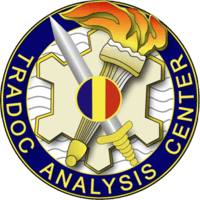United States Army Training and Doctrine Command Analysis Center

The United States Army Training and Doctrine Command Analysis Center (TRAC) is an analysis agency of the United States Army. TRAC conducts research on potential military operations worldwide to inform decisions about the most challenging issues facing the Army and the Department of Defense (DoD). TRAC relies upon the intellectual capital of a highly skilled workforce of military and civilian personnel to execute its mission.
TRAC conducts operations research (OR) on a wide range of military topics, some contemporary but most often set 5 to 15 years in the future. How should Army units be organized? What new systems should be procured? How should soldiers and commanders be trained? What are the costs and benefits of competing options? What are the potential risks and rewards of a planned military course of action? TRAC directly supports the mission of the Army's Training and Doctrine Command (TRADOC), to develop future concepts and requirements while also serving the decision needs of many military clients.
TRAC mission statement
To produce relevant and credible operations analysis to inform decisions. TRAC serves many clients and has many stakeholders, but has only one shareholder: the American Soldier.
TRAC organization
TRAC is led by a civilian SES director, subordinate to the Commanding General of the US Army Training and Doctrine Command, and comprises four centers:[1]
- TRAC-Fort Leavenworth (TRAC-FLVN), led by a civilian SES director, is co-located with TRAC headquarters at Fort Leavenworth, Kansas (i.e. US Army Combined Arms Center (CAC)) and has traditionally conducted analysis at the operational level (i.e. Corps and Division).
- TRAC-White Sands Missile Range (TRAC-WSMR), led by a civilian SES director, is located at White Sands Missile Range in New Mexico and has traditionally conducted analysis at the tactical level (i.e. Brigade and below).
- TRAC-Lee, led by a civilian GS-15, is located at Fort Lee, VA and has traditionally conducted analysis in the area of Logistics.
- TRAC-Monterey, led by a Lieutenant Colonel (LTC), is co-located with the Naval Postgraduate School (NPS) in Monterey, CA and has traditionally utilized the resources of NPS to conduct research into new models and methodologies.
Each center director is subordinate to the TRAC director.
TRAC headquarters has three components:
- The director's staff element comprising the deputy director, an O-6 colonel, and administrative assistants
- The Program and Resources Directorate (PRD), in coordination with center directors, oversees the day-to-day operations of all TRAC elements
- The Methods and Research Office (MRO) conducts research into analysis of cutting edge military operations.
The discipline of OR
The discipline of operations research is built upon the collaboration of interdisciplinary team members who have mutually supporting knowledge, skills and experiences pertinent to the study problem. The TRAC building blocks of military operations analysis are future scenarios; leading edge models and simulations; realistic data about systems, forces, and behavior; and skilled operations analysts. Leading a core team of analysts, a TRAC Study Director may receive support from other TRADOC and Army agencies, and from other government agencies and industry as well. TRAC adheres to the proven principles of scientific inquiry and applies the problem solving model to perform its analysis.
The TRAC program
The TRAC program of operations research and analysis is forward-looking and addresses a wide range of military topics. The analysis is conducted within a joint framework of combined arms operations across a full spectrum of missions and environments. TRAC leads TRADOC's major studies of new warfighting operations and organization (O&O) concepts and requirements. TRAC leads the Army's analysis of Advanced Warfighting Experiments (AWEs), and the Army's Analysis of Alternatives (AoA). The analysis topics span doctrine, training, leader development, organization, materiel, and soldier support.
Scenarios are used by the U.S. Army for education, training and force development. Director, TRAC is the TRADOC executive agent for development of scenarios for use in studies and analysis.[2] TRAC develops scenarios of potential military operations set in the future for use in modeling and analysis. TRAC relies upon input and assistance from many Army and DoD agencies, other Services and the Combatant Commanders to develop and apply a family of scenarios depicting joint operations of corps and divisions, and brigades and battalions. The family of scenarios undergoes continual review and change in anticipation of emerging threats and new operational environments around the world based on intelligence estimates.
Tools
Military operations are highly complex processes and typically must be modeled in order to be analyzed. The analytic tools may take the form of:
- table-top map games,
- human-in-the-loop (HITL),
- (HITL) simulations and simulators,
- closed-form Models & Simulations (M&S), and
- controlled field experiments.
TRAC develops and maintains a class of warfighting M&S referred to as force-on-force, ranging from individual objects (e.g., soldier, weapon, terrain feature) to aggregated objects (e.g., battalions) at corps level. TRAC M&S represent the Army's de facto standards for force-on-force M&S and are widely used by military, industry and allies. TRAC is a significant contributor to advanced M&S research and improved modeling methodologies in the military.
References
External links
| Wikimedia Commons has media related to United States Army Training and Doctrine Command Analysis Center. |
- U.S. Army TRADOC Analysis Center (TRAC)
- U.S. Army TRADOC Analysis Center (TRAC) Video
- U.S Army Training and Doctrine Command (TRADOC)
